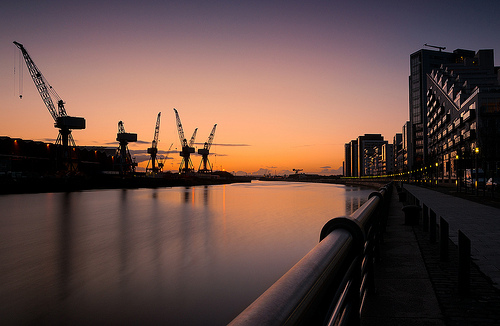Glasgow
By the 1800’s Glasgow had become the world’s major centre of ship building and the second most important city in the whole of the British Empire. The city of Glasgow owes its origins to St Mungo who established his church here in 600AD. He was the Archbishop for Strathclyde and it is believed that the name of the city was taken from his description of the community that lived here at that time ‘Clas-gu’ which translates to ‘Dear Family’. It became a city that was based upon the church and it grew quickly up until the reformation in 1560.

Industrial Heartland
As the city entered the 1700’s it had developed lucrative trade links, especially with America and the importation of Tobacco, but with the onset of American independence much of the tobacco trade disappeared. Yet Glasgow continued to grow, forging new trade links and increasing its domestic industries. The vast amount of heavy industry that has taken place in the city has given it the reputation for being a harsh and gritty city, having been long regarded as one of the most deprived areas of Scotland. Yes Glasgow continues to bounce back, as you arrive in the city you can almost feel the renewed energy and enthusiasm of the place. Glasgow is now a centre of culture and entertainment with many museums and galleries for visitors to enjoy, as well as gardens and open air spaces.
Must Visit Attractions
Now you may not initially think of a cemetery as being a tourist attraction, but Glasgow Necropolis is just that. The tombs and mausoleums here are a testament to the disposable wealth of the Victorian Merchants that established the necropolis. Some of the monuments stand over 35ft tall and are something to see. When you make it to the top of the hill where the largest and most impressive monuments are you will be able to see some of the best views across the city, and over the cathedral than you could ever hope to see, so make sure that you have your camera with you.
The riverside museum is a recent addition to the list of tourist attractions in the city; it opened in 2011 and has been steadily increasing in popularity. Situated in what is now called Glasgow harbour it is home to the Glasgow Museum of Travel and Transport; this is a free entry museum though if you wish to board the Tall Sip that is moored at the quayside you will have to pay. The museum houses some incredible exhibitions like the wall of cars for example and then further around the building, the wall of motorcycles.
Diverse Architecture
Much of the medieval city has been lost to the ravages of time, with the Cathedral and Provand’s Lordship being the last remaining buildings from the time period. Much of the other remaining buildings were cleared when the city underwent redevelopment in the 1800’s. The new city developments were designed on a grid pattern set out around Sauchiehall Street, Buchannan Street and Argyle Street. These days Sauchiehall Street is the place to go to indulge in some amazing retail therapy. As with its sister city of Edinburgh, the grid layout makes it difficult to get lost in the city’s streets. As you walk around the city you will see some amazing Gothic architecture set alongside some more contemporary buildings. Yet they somehow seem to work together to make a harmonious union.
Amazing Entertainment
There are some fabulous bars and cafes in the city, where if you need a break from pounding the streets you can rest a while and watch the world go by as you enjoy a coffee or something a little stronger. Glasgow has some incredible restaurants too, including two with coveted Michelin stars. Theatres, comedy clubs, and a variety of night clubs are all available should you have the desire for some evening entertainment. The pubs and bars in the city centre get really busy of an evening, especially at weekends, so be prepared to negotiate your way to the bar occasionally. For a city that has suffered for years with a bad reputation it is really an exciting place to be, perfect for a city break adventure.


